This was published 4 years ago
Dublin, Ireland: a traveller's sporting guide to the Emerald Isle
By Liam Phelan
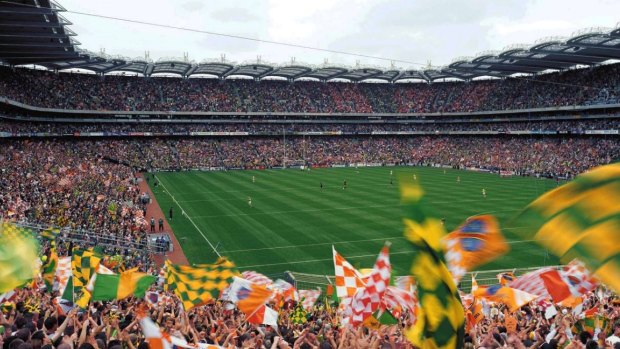
Flags flying at match day in Croke Park.Credit: DRTA
Dublin has come to a halt. Empty double-decker buses rumble past empty stops on deserted streets. Even the coastal cries of wheeling seagulls arcing over the River Liffey have been silenced.
And then, suddenly, a booming wave of sound rumbles from every pub, hotel, bar and shop across the capital. "Goaaaaaal." Striker Robbie Keane has just scored the equaliser for the Republic of Ireland football team against Spain in the 90th minute of the quarter-final of the 2002 World Cup in South Korea.
The city goes bonkers. Men roar. Women dance. In the packed bar of a pub in North Wall, a complete stranger grabs my wife's pregnant belly with both hands and shouts in a thick, Dublin brogue: "If yez have a boy, yez'll hafta call him Robbie. And if it's a girl ..." He grins. "Call her Robbie anyway."
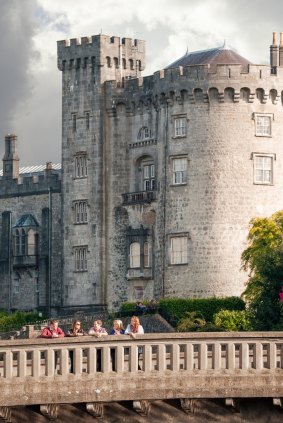
Kilkenny Castle is one of the features of the town's Medieval Mile. Credit: Finn Richards
It is a moment that neatly sums up the passion and collective mania that sport creates in the land of saints, scholars – and strikers. For many travellers, sport is something of a mystery, a fever that locals catch but to which visitors are immune. But if you want to understand a country's character, passions, obsessions and even its cultural history, buy tickets for a popular local game.
Ireland is a small nation with a big passion for sport. Ground zero for a sporting introduction to Ireland is Dublin's 82,300-seat Croke Park, the third-biggest stadium in Europe. It's the headquarters of the Gaelic Athletic Association (GAA) and it's where the Irish sports of Gaelic football and hurling are played.
There is nothing quite like the excitement of an All-Ireland final in either code, when capacity crowds belt out their support for their county side. It's a uniquely Irish spectacle, and while the crowds are passionate, the ethos of good sportsmanship shines through. It can be notoriously difficult to buy a ticket for these events, so you're probably better off going to one of the many qualifying games. If you can't get to a live game, Croke Park is home to the GAA museum and its stadium tours are one of Dublin's most popular attractions.
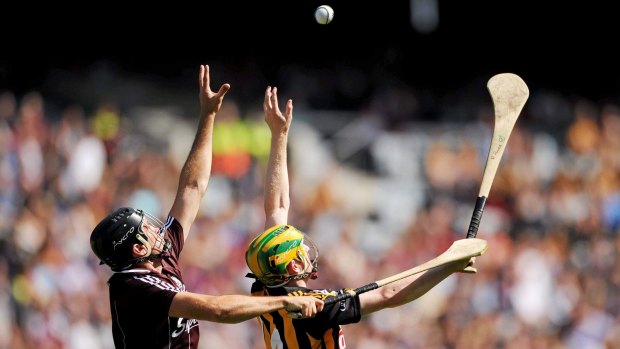
Hurling is described as a combination of ''hockey, lacrosse and second-degree murder''.Credit: Sportsfile
The stadium, known to Dubliners as "Croker", holds a unique place in Irish history. The first games were played on the site in 1891. The GAA bought the grounds in 1913 and named it after Archbishop Croke of Cashel, who was an early patron of the association.
However, the GAA was more than just a sporting organisation. In the centuries of struggle for Irish independence, the GAA was seen as a political group by the British, and in 1918 it was declared a dangerous organisation and Gaelic games were banned. Hurling had already been frowned upon by the English, who as early as the 12th century had restricted the game. Former GAA president Aogan O'Fearghail calls hurling a "warrior sport".
"We know from history that Celtic warriors used hurling to train their young men before going into battle," he says. And when you watch a game today it still resembles a battle."
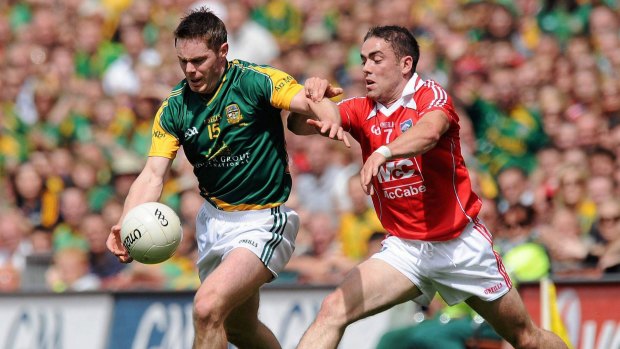
Gaelic football is one of the most popular sports in Ireland.Credit: Sportsfile
Our Croke Park guide describes hurling as a combination of "hockey, lacrosse and second-degree murder". It's the fastest field game on the planet and, according to our guide, "the greatest game in the world".
A key event in Irish history occurred at Croke Park on November 21, 1920, when 10,500 people gathered to see Dublin play Tipperary. Earlier that day rebel leader Michael Collins had launched an audacious raid on a team of undercover British intelligence agents.
In retaliation, British troops entered the stadium and opened fire during the game. Thirteen spectators and one Tipperary footballer, Michael Hogan, were killed and the event became known as "Bloody Sunday". This memory helped cement the role of the GAA in Irish sports and culture. It also reinforced its suspicion of "foreign sports" such as soccer and rugby union, which have eclipsed the Irish games in popularity in recent years.
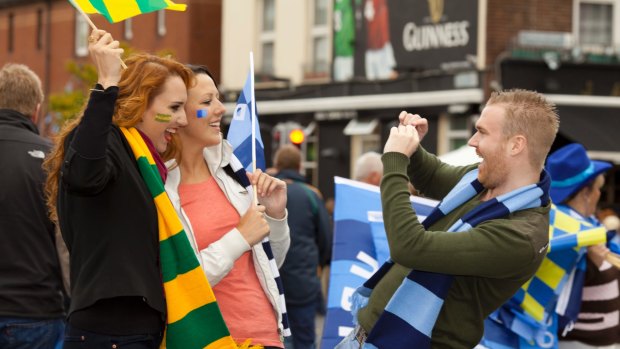
If you want to understand a country's character, passions, obsessions and even its cultural history, buy tickets for a popular local game.Credit: dav
The other big stadium in Dublin is Aviva, known as Lansdowne Road. It's home to rugby and soccer and was completely rebuilt in 2010 at a cost of €410 million. Again, it can be hard to get tickets for the big games, but you can do a stadium tour in between Tests. It's on the city's south side, but is easily accessed by DART train.
While it's not as big as Croke Park, with a capacity of 51,700, it's more modern and equally capable of producing a boiling cauldron of passionate fans. An international game is a huge day in Dublin with many fans gathering in Temple Bar well before the game to "warm up". If you're lucky enough to be in town for a Wales, Scotland or England game you will hear musical fans belt out national songs in glorious harmonies. Aviva is also home to rugby union side Leinster, who play their home games in European club competition the Heineken Champions Cup here.
Although rugby is not native to Ireland, it has also managed to unite the nation in a way that politics can't, with the Ireland team picked from all 32 counties (which is why Ireland's Call is sung at rugby internationals, rather than the Irish or English anthems). As an example of just how dear the sport is to the nation, John Breen wrote a popular play, Alone It Stands, about the time in 1978 that provincial side Munster beat the New Zealand All Blacks.
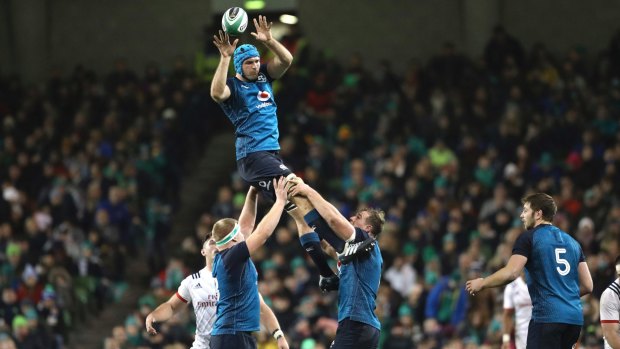
The second biggest stadium in Dublin is Aviva, known as Lansdowne Road, which is home to rugby and soccer.Credit: Peter Morrison
To continue your sporting education outside the capital, visitors should head to Kilkenny, less than two hours' drive from Dublin. It's a picturesque town that dates back to medieval times and is great for shopping and sightseeing. It also happens to be the spiritual home of hurling and county manager Brian Cody is a local and national hero. He has managed the county side since 1988, winning 42 titles, including 11 All-Ireland Championships.
"Hurling is a game of huge skill. It's very physical, and is played with both pace and passion," the tall and still impressively fit 64-year-old explains. We meet in the foyer of the Ormonde Hotel, a good place to base yourself for an overnight visit. "The game offers visitors a unique insight into Irish culture, it is steeped in history," Cody says.
County finals take place in Nowlan Park stadium, which holds 27,800, but for something completely different, we watch the quarter-final club clash between Erin's Own and Brian Cody's former side, James Stephens, in the village of Ballyragget, a short drive from Kilkenny. Most villages have a GAA ground, thanks to the association's community development ethos, and cars and coaches pour into the Ballyragget grounds.
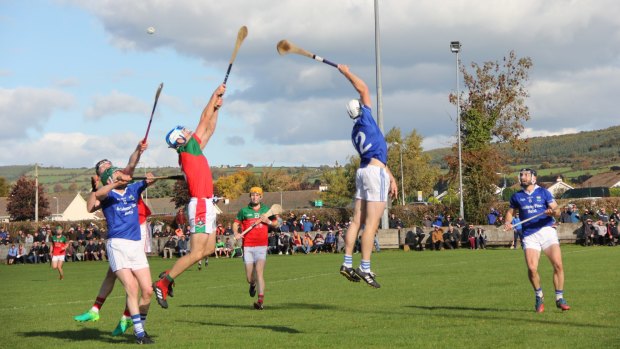
Players from hurling clubs James Stephens and Erin's Own do battle in a quarter-final clash in Ballyragget, County Kilkenny, Ireland.Credit: Conor Phelan
The fans know all the players' names and every decision by the referee is met with roars of protest or approval. The clash of the ash hurley sticks competes with the outrage and encouragement of thickly-accented fans screaming from the sidelines. At half-time, the field is swarmed by children, who practise their skills belting the sliotar (leather ball) with miniature hurleys. It's a close match and finishes up at 14 points apiece, with a rematch two weeks later. Being an amateur sport, both hurling and Gaelic football heavily rely on ticket sales for revenue, so there seems to be a suspicious number of draws in big games.
After the afternoon's entertainment it's time to return to Kilkenny for a late lunch and some retail therapy, both of which are well catered for in the town's Medieval Mile, which takes in Kilkenny Castle, the Kilkenny Design Centre and Rothe House. The Design Centre is a great spot to pick up a gift and features the famous spongewear pottery of Nicholas Mosse.
Other famous counties for hurling include Galway, Limerick, Tipperary and neighbouring Wexford. Each has its own stadium and unique passion from local fans. Gaelic football is a stronghold in Dublin, Mayo, Kerry and Cork. Rugby is played in Dublin, Galway, Cork and Limerick.
And Ireland's national soccer team? Probably best not to ask how they've gone since the 2002 World Cup. But your chance of being grabbed by a total stranger and told to name your child after one of its team members today is pretty slim.
OTHER TOP IRISH SPORTS
HORSE RACING
Is a huge attraction for Irish and overseas visitors and Tipperary's Coolmore Stud has bred many of the world's best horses. The Curragh, 2000 hectares of grassland west of Dublin, has a great racecourse and is home to the National Stud. One of the major events of the year is the Galway Races, which begins on the last Monday of July every year.
GOLF
Although most people think of Scotland as the home of golf, Ireland is not far behind, with the recent success of Northern Ireland's Rory McIlroy helping spark popular interest in the sport. There are more than 300 courses throughout the island but two standouts are Old Head, at Kinsale in Cork, and Royal Portrush, which plays host to the British Open in July.
ROAD BOWLING
For something completely different, head to County Cork, which is home to the unusual sport of road bowls, where players lob a metal ball along a set length of an open road in the least number of throws. This Irish sport is also played in county Armagh, north of the border.
TRIP NOTES
Liam Phelan travelled to Ireland as a guest of Tourism Ireland.
MORE
FLY
Emirates and Etihad fly daily to Dublin. See emirates.com/au ; etihad.com
STAY
The Croke Park Hotel has rooms from €139 a night. See doylecollection.com
If you want to stay near Aviva Stadium, Balls Bridge Hotel has rooms from €133 a night. See ballsbridgehotel.com
In Kilkenny, Ormonde Hotel has rooms from €80 a night. See kilkennyormonde.com
SEE
Tours of Croke Park and Aviva Stadium are offered daily with some adjustments on match days. See crokepark.ie; avivastadium.ie
Kilkenny's Medieval Mile is a great place to wander and buy the work of local craftspeople. See kilkennycityonline.com
Sign up for the Traveller Deals newsletter
Get exclusive travel deals delivered straight to your inbox. Sign up now.